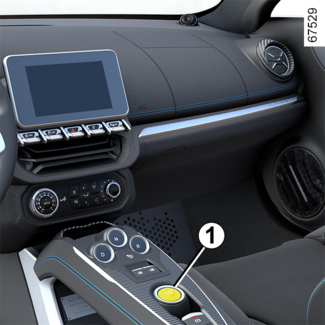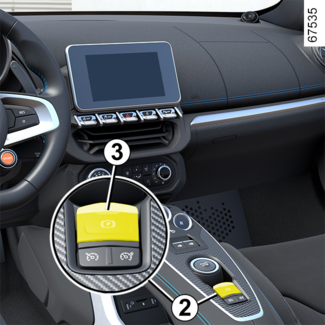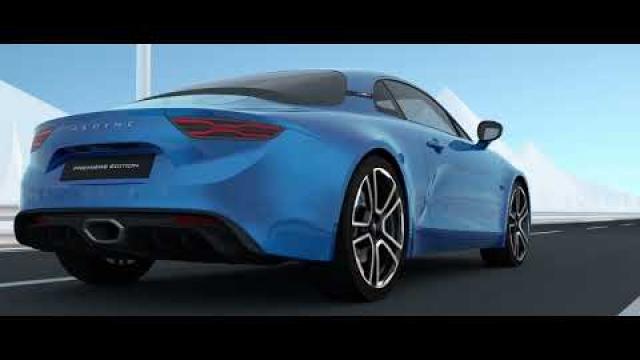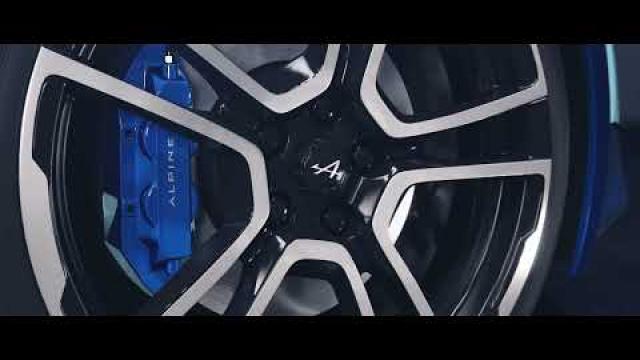Back to the list



Electronic parking brake
Electronic parking brake
Assisted operation

Applying the electronic parking brake
With the vehicle stationary, the electronic parking brake immobilises the vehicle
when the engine start/stop button is pressed 1.

In all other cases, for example, stalling of the engine or the engine going on standby as a result of the Stop and Start function (refer to "Starting, stopping the engine" and "Stop and Start function" in Section 2), the electronic parking brake is not applied automatically.
Manual mode must be used.
For certain country-specific model versions, the assisted brake application function
is not activated. See the information on "Manual operation".
To confirm that the electronic parking brake is applied, the "Parking Brake ON" message and the " " warning light appear on the instrument panel and the indicator light 3 lights up on the switch 2.
" warning light appear on the instrument panel and the indicator light 3 lights up on the switch 2.
After the engine is switched off, the indicator light 3 goes out a few minutes after the electronic parking brake has been applied and the
 warning light goes out when the vehicle is locked.
warning light goes out when the vehicle is locked.
Note: to indicate that the electronic parking brake is released, a beep sounds and the "WARNING: Apply Parking Brake" message appears on the instrument panel:
- with the engine on: when the driver’s door is opened;
- with the ignition switched off (e.g. if the engine stalls): when a door is opened.
In this case, pull and release the switch 2 to apply the electronic parking brake.
Assisted release of the parking brake
The brake will be released as soon as the vehicle starts and accelerates.
WARNING
Special feature related to the Stop and Start function: if the driver's seat belt is unfastened before the engine goes on standby due to the Stop and Start function, make sure that the parking brake is applied: the  warning light appears on the instrument panel to confirm this.
warning light appears on the instrument panel to confirm this.
Risk of loss of immobilisation.
WARNING
The electronic parking brake can be used to immobilise the vehicle. Before leaving
the vehicle, check that the electronic parking brake is fully applied. Application
of the parking brake is confirmed by the illumination of the indicator light 3 on the switch 2 and the  warning light on the instrument panel until the doors are locked. Depending on the
vehicle, a label may be located at the top of the windscreen to remind you.
warning light on the instrument panel until the doors are locked. Depending on the
vehicle, a label may be located at the top of the windscreen to remind you.
Brief stop
To apply the electronic parking brake manually (when stopping at a red light, stopping
when the engine is running, etc.): pull and release the switch 2.
The brake is released as soon as the vehicle is started up again.
Manual operation

You can apply the electronic parking brake manually.
Manually applying the electronic parking brake
Pull the switch 2. Warning light 3 and warning light  on the instrument panel light up.
on the instrument panel light up.
Manually releasing the electronic parking brake
With the ignition on, press the brake pedal then press the switch 2: the warning light 3 and the  warning light disappear.
warning light disappear.
Special cases

To park, with the electronic parking brake released (if there is a risk of freezing,
for example):
- stop the engine by pressing the engine Start/Stop button 1;
- check that the N switch indicator lights up in red and that the Park position P warning light is displayed on the instrument panel;
- depress the brake pedal then release the electronic parking brake manually.
For vehicles fitted with the Stop and Start function, with the engine on standby, the electronic parking brake is automatically
activated if the driver unfastens their seat belt or opens the driver's door or gets
out of their seat.
WARNING
If the "WARNING: Electric System" or "Check battery" or "WARNING: Braking System" message appears, you must immobilise the vehicle, engaging the first gear (on a
manual gearbox) or P position (on an automatic gearbox).
If the conditions and the slope require it, chock the wheels of the vehicle.
Risk of loss of immobilisation of the vehicle.
Call an approved dealer.
WARNING
Never leave your vehicle without setting the gearbox to P position and switching off the engine. This is because when the vehicle is stationary
with the engine running and a gear engaged, the vehicle may begin to move.
There is a risk of accidents.
For safety reasons, the automatic release is deactivated when the driver's door is
open or not shut properly, the driver's seatbelt is not fastened and the engine is
running (in order to prevent the vehicle from moving without the driver).
The "Release Parking Brake" message appears on the instrument panel when the driver presses the accelerator
pedal.
WARNING
If no lights or sounds are apparent, this indicates a fault in the instrument panel.
This indicates that it is essential to stop immediately (as soon as traffic conditions
allow). Ensure that the vehicle is correctly immobilised and contact an approved Dealer.
Operating faults
- If there is a fault, the
warning light illuminates on the instrument panel accompanied by the "Check Parking Brake" message and, in some cases, the
warning light.
Contact your approved Dealer straight away.
- If there is an electronic parking brake fault, the
warning light comes on, along with the "WARNING: Braking System" message, a beep and, in some cases, the
warning light.
This means that you must stop as soon as traffic conditions allow.
WARNING
It is therefore essential to immobilise the vehicle by setting the gearbox to P position. Depending on the slope, chock the vehicle.


